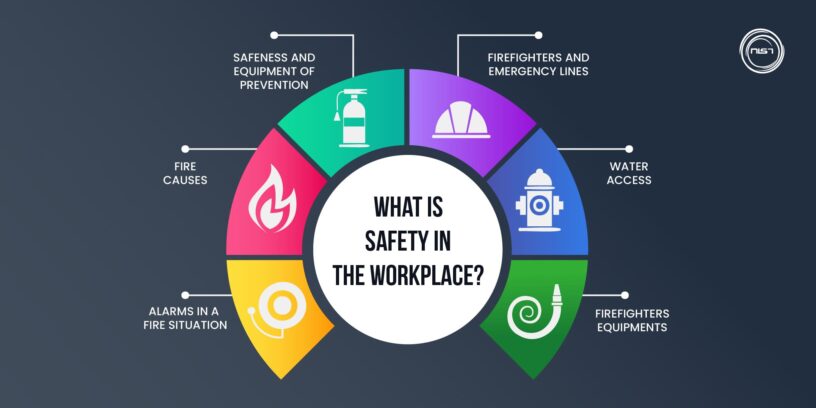First, we will ask ourselves what safety means to us. Safety is the state of being free from danger. In the workplace, safety is essential to ensure efficient operations. Organizations should place a high priority on safety since workers who are exposed to hazardous conditions run the risk of getting sick or hurt. Employees should always feel safe at work, and employers should ensure this for all of their staff.
Safety is a difficult concept to grasp for most people, and yet there are many examples of safe and unsafe work conditions throughout history. Our current workplace safety measures are not something to be taken lightly. In this article, we’ll examine some strategies for enhancing workplace safety. Finally, we will look at what we should do when we come across risky situations.
In every workplace, safety is a top priority. The workplace is the physical environment for work. It’s where workers carry out their jobs and produce goods or provide services to clients. Employers should be cautious about the materials used in construction, furnishings, and machines at work sites. They should also make sure that tools and electrical devices used at work are safe and hazard-free. Working conditions can be hazardous if employers fail to take safety precautions.
Why Safety is important in the workplace?
Safety is paramount in the workplace. Employers are required to take all necessary steps to ensure worker safety. Employees have a responsibility to report any hazards they see so that they can be taken care of. Employers and employees both contribute to a healthier environment by working to make the workplace safe.
A safe workplace,
- Save lives
- Ensures no one is injured or killed while performing their duties
- Increases employees’ confidence
- Decreases absenteeism
- Helps in retaining employees
- Promotes employees, employers, and clients’ well-being and increase productivity
- Ensures on-time completion of projects
- Helps in avoiding liability claims
- Will lower employer’s insurance premiums
- Reduces time and effort
- Increases the firm’s reputation
The law demands it:
Employers have to take steps to make sure that their employees are not harmed while at work. In fact, the law demands it and so it’s employers’ moral obligation to provide a safe working environment for their employees by removing hazards from the workplace. The 1994 OSHA standards place a strong emphasis on safeguarding employees’ welfare, safety, and health from all risks and hazards at work.
Safety- A shared responsibility:
Workers should be encouraged to report any hazards they see so that they can be dealt with promptly. This way, everyone can focus on their jobs without being distracted by safety concerns. Plus, workers will feel more comfortable performing their duties when they know the workplace is safe and free of hazards.
Workers also have a duty to keep the workplace safe and secure for themselves while at work. Most workplaces have some sort of safety manual or code of conduct for this purpose. These documents outline what is acceptable behavior at work and what kind of behavior leads to disciplinary action from management teams or fellow workers alike. The goal here is to promote good habits at work such as eating meals on time, arriving on time, and taking breaks when asked to do so by management teams). This way, people won’t end up working themselves to exhaustion causing serious health issues later in life— dangerous consequences that would never happen in a healthy workplace environment first place.
A safe environment:
The workplace should be a safe environment for workers. For example, workers may have to use power tools or heavy machinery that could hurt them or damage their working environments. Employers should assess the safety of all equipment before allowing workers to use it and should keep equipment up-to-date with current safety standards. They also need to train their workers on how to use equipment safely and effectively without endangering themselves or others. Workers can easily become injured on employers’ property if it’s not safe enough for them to do as they wish.
Working conditions can also negatively affect environmental health by creating noise pollution, carbon emissions, vehicle exhausts, toxic chemicals, etc. Unsafe working environments harm not only workers but also nature as they create environmental hazards such as carcinogens and explosions.
Types of hazards:
There are many types of safety hazards at work – from chemicals and machinery to electricity fire, biological, ergonomic, physical, and psychological, all of which need to be carefully managed and controlled so that they cause no harm to people or property, or cause damage to the environment.
A Hazard could be anything:
A Hazard could be anything. In many cases, the hazard is something as basic as a loose screw or piece of equipment. Not all hazards are dangerous and could cause injuries if touched by an employee. Employers should be sure to remove anything that could cause harm or discomfort for their workers regardless of how trivial it may seem. Even something as minor as an untidy workspace can lead to accidents if left unaddressed by management. By taking these steps, workplaces become much more conducive for both employers and employees alike.
Working towards safety and making your job safe and secure seems like a good idea no matter how you look at it— it promotes healthy living for everyone involved and prevents injury or death in the workplace instead! Installing safety measures such as hazard identification software ensures that no one gets hurt while performing duties at work either. Plus, promoting safety behaviors at work creates an optimal working environment where everyone can do their best without fear of reprisals from superiors or coworkers alike!
When it comes to dealing with workplace safety risks, the OSHA (Occupational Safety and Health Administration) has made it clear what the employer’s obligations are: “An employer shall protect its workers from any hazardous conditions which exist in the place of employment even if such protection requires that steps be taken to remedy the such condition and even if such remedy will be more expensive than the cost of compliance with the standard” (OSHA 2010). This indicates that even if the work being done poses a risk of injury, an employer must still take precautions to protect its employees.
Safety in the workplace is essential for protecting both employees and natural resources from damage and injury. Businesses that take safety seriously will have fewer work-related accidents and illnesses, making employees much more comfortable at work without exposing them to harm or danger, either physical or mental Inferior safety practices lead to dangerous workplaces filled with unsafe equipment that causes injuries and illnesses among employees as well as damage to natural resources around businesses. Although it may appear difficult at first, creating a safe working environment can greatly increase workplace productivity while also reducing worker discomfort.
Workplace hazards:
Here are some of the most common hazards that affect workers on the job:
- Falls, slips, Trips
- Lack of proper maintenance or repair
- Water spills
- Work at height
- Electric shocks
- Exposure to dangerous chemicals
Some tips to reduce/mitigate Hazards are:
- Proper personnel training in their particular industries is one way to minimize or lessen hazards. For instance, training on “Work at Height” will assist learners in comprehending their responsibilities as an employer, suppliers, supervisors, and workers with regard to working safely at heights.
- Identifying potential issues in the workplace and addressing those
- Regular mock drills being conducted at the workplace
- Using first aid kits, fire shelters, and first aid kits, on a ladder or scaffold
- Use of safety nets and other rescue equipment at heights
- Having portable fire extinguishers in the workplace
- Training employees on common injury techniques and safe work habits
- Carrying out regular risk assessment projects at the workplace and applying a risk management strategy
- Implying and communicating safe systems in the workplace
- Developing strategies for safety and health improvement inside workplaces
- Proper disposal of hazardous chemicals in industries
- Scaffolding, electrical, work at height, confined space, construction, fire, chemical safety training, etc., must be covered in employee training
- Ensuring employees are aware of the company’s policies and workplace processes
- Conducting regular audits in the workplace
- Having a written hazardous spill response plan and training in chemical industries
- Listing out emergency/evacuation plans in the workplace and communicating them to workplace members
- Installing fire/smoke alarms
- Usage of correct PPE
Benefits of taking Safety courses:
A NEBOSH qualification,
- Provide you with the knowledge and skills needed to work in a safety field
- Helps learners stay safe in the workplace
- Help you find work and improve your employability
- Elevates your profile above that of others
Why NIST?
NIST is India’s first and foremost gold learning partner. We understand the risks associated with work and have developed our training programs to make sure your workers are well-prepared before they head off into their work environment. Our NEBOSH and IOSH courses are designed to help you keep your workers safe and ensure they know what steps to take when in danger. These courses have received widespread recognition on a global scale due to the high standards they uphold. There are four levels of the course, with the highest level being the most challenging and advanced. Our classes are also suitable for apprentices and trainees who will be handling equipment or materials that could potentially pose a risk. Our wide range of other health and safety courses includes firefighting training, industrial hygiene training, emergency services training, first aid training, hazardous materials awareness training, and even CPR/AED training, construction safety training, etc. To find out more about what we offer, visit our website or call us at + 91 8056000530 or email us at info@nistinstitute.com. Happy Learning!












Leave a Reply